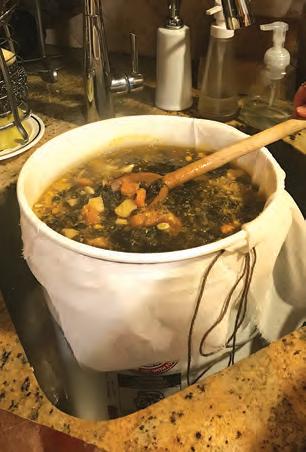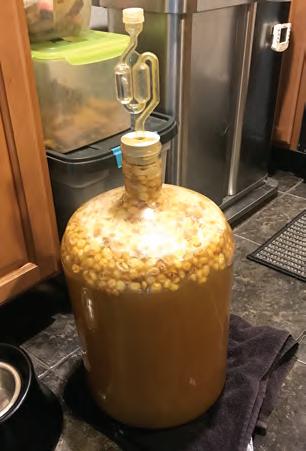
4 minute read
In Search of Dandelions: Flower Wine Making Under Lock Down by Michelle LaFranceEMT’s: Eastern H
In Search of Dandelions Flower Wine Making Under Lock Down
by Michelle LaFrance I t’s the first day of the stay-at-home order, but I’m in a field in Northern Virginia, fifteen miles from my home, bowing to finger through the speedwell, cleavers, purple deadnettle, purslane, chickweed, and clover. I’m collecting a plastic grocery sack full of fat, wide-open dandelions. My thumbnail is grimed with the gooey black sludge of lush stems. My fingers and palm are coated with Only wide-open flowers will do a thick yellow paste—dandelion pollen. The world feels like it’s in a scary freefall; but in this moment I’ve found a meditative rhythm. Peace of breath and motion amidst the furor.
I brew flower wines. Dandelion wine is one of my favorites to make. Every spring, I am out somewhere in the DMV, collecting dandelion heads, so that I can stew the flowers with sugar, citrus fruit, and spices, then ferment the mix into a golden-yellow wine. A year and a few months later, the taste mellows into a smooth and ginger-sweet beverage. It’s been my spring ritual for five years now, but the process has taken on special significance this year, the year of Coronavirus.
The Value of Small (and Common) Things
Most people think of the dandelion as a spring nuisance. They are remarked upon for their weedy tenacity—their fierce yellow heads and scalloped leaves take root in a crack in the pavement and in disturbed soils where little else would choose to grow. Found around the world, dandelion is known by a number of names that reference its bitter taste, golden and mature flowers, and its ubiquity: bitterwort, cankerwort, clockflower, common dandelion, blow-ball, puffball, Irish daisy, piss-in-bed, pissinlit, priest’s crown, swine’s snout, telltime, and yellow gowan. Its English name is said to be derivative of the French dent-de-lion or lion’s tooth.
The plant itself is remarkable for its resilient bioengineering. Its tap root reaches deep into the dirt and will re-grow a whole new plant if broken off. What we see as a single yellow flower is, in fact, a head of unique florets, each with its own seed. These will dry into the highly recognizable puff ball and scatter on the winds in its later stages of growth. For wine making, you want to pick only the flower. The greens—the involucral bract, receptacle pedicel (or stem), any small trace of grass leaf or stray deadhead--will turn the wine bitter.
Some sources claim that dandelion was brought to the US with early European colonists who planted medicinal herb gardens, thus seeding the North American continent. Its medical uses are extensive and the dandelion has been used around the globe—in Arabian, Native American, Chinese and Ayurvedic medicinal practices—to treat a range of ailments. Naturopaths and herbalists of today note the immunostimulatory, antitumor, anti-inflammatory, antimicrobial and anticoagulant, and antioxidant properties of the dandelion. There’s no shortage of online sources or recipes to harness the dandelion’s “healing” power.
The origin of dandelion wine is often ceded to the ancient Celts and Anglo Saxons, though the Greek naturalist Theophratus prescribed a “dandelion tonic” to treat freckles and liver spots. Northern Europeans historically drank the wine and derivative liqueurs to prevent scurvy and as a diuretic and laxative. Folklorists have collected dandelion wine recipes from homebrewers across Ireland, the UK, and Northern Europe, and subsequently in many US-locations where the Gaels and other Northern Europeans settled—an inexpensive and useful spring brew.
This Work of My Hands
My forays for dandelions this spring have all been edged with a sense of audacity and purpose—an act of resistance in a time when leaving the house carries any number of social implications. And yet, I couldn’t shake the need; I had to make wine this year. I needed the brush with normalcy after all the other cancellations, plan b’s and setbacks of the previous months. I craved the comforts of a detailed and time-consuming project.
Gathering enough dandelions is the first and the hardest step in making dandelion wine. The trick is to find a field or lawn that has not been treated with fertilizers or weed killers. I prefer to gather away from busy roads and areas that have been or may be polluted with exhaust or other run off. I also avoid the “pee zone,” which often coincides with dandelion hot spots, such as busy corners and walk ways where dogs habitually mark.
Planning for and strategizing collection typically begins in mid-March as I case potential sources. Some years, when I lived in a rental house outside the city, I was
Dandelion flowers stewed with citrus and ginger


The stew is called “must.”










